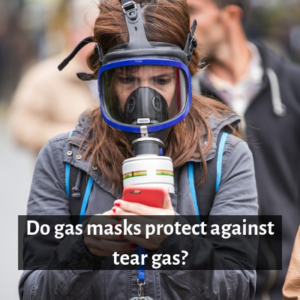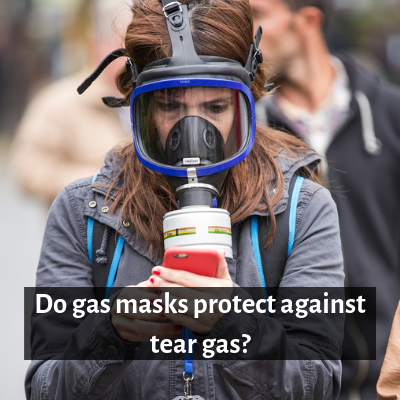
Does Gas Masks Protect Against Tear Gas?
A gas mask can protect you from tear gas, as well as pepper spray. In general, a gas mask is designed to prevent the wearer from inhaling hazardous particles or chemicals which may be floating in the air.
If you are looking to buy the best gas mask for a reasonable price, check Amazon, this is what I would recommend.
It also protects your facial skin from any possible burning sensations or other symptoms as well. Overall, gas masks are considered to be respirators because they prevent the nose and mouth from inhaling dangerous airborne elements.

Tear gas is supposed to be used to temporary incapacitate people; kind of like how pepper spray does. However, the difference here is that tear gas causes the recipient to experience more serious and longer lasting symptoms. It also comes in two different forms: a grenade canister or spray.
If it’s a grenade canister, then a baton gun is used to fire it. Canisters are actually more dangerous because they generate excessive amounts of heat, which can burn people’s skin at close range.
What are the tear gas effects?
At close range, tear gas can cause permanent bodily harm or even death. Generally, though, tear gas will only cause a person to experience a temporary burning sensation on their skin, eyes, and lungs.
In fact, the lungs are targeted more by the tear gas. So, anyone with asthma or other respiratory diseases may experience a serious injury or death from an encounter with tear gas.
How to protect against tear gas?
On the other hand, if you wear a gas mask to protect your nose, eyes, and mouth, then you won’t experience any of these symptoms. If you don’t have gas mask here is an article on how to survive tear gas without
Gas masks basically serve as respirators, but they’re quite expensive for the average person to buy. That is why you typically see public officials wearing them only. Some jurisdictions have laws which regulate who can wear them. Civilians are not always allowed to wear them in certain areas.
Gas masks are made of rubber and have a filter and canister attached to them. You should be able to withstand tear gas for up to a few hours with a gas mask on your face. By that time, the filter and canister will need to be replaced.
Of course, most people don’t stand around in tear gas for that long, so you’ll probably get multiple uses out of your gas mask before it needs its filter and canister replaced.
What can a Gas mask protect you from?
There are different types of gas masks available. Before you purchase a gas mask, you must figure out which type of hazard you’re trying to protect yourself from.
Each type of gas mask is made to protect the wearer from a specific type of hazard. The main type of gas mask is the air-purifying respirator. This is what law enforcement officers wear after they throw a tear gas canister on the ground or inside of a building.
Air-purifying respirators are designed to filter out the hazardous chemicals and gases in the air around the wearer. That way, they’ll be able to breathe in clean air while standing in a hazardous environment.
For instance, if a biological weapon has released toxic particles into the air, then military officers could protect themselves from those particles by wearing air-purifying respirators. The same goes for tear gas, charcoal, or any dangerous gases in the air.
Alternatively, there are particulate respirators which only protect the wearer against airborne particles. They’re lower quality and more affordable, but they don’t offer protection from vapors, chemicals, or gases.
If you need protection from smoke and gas in an emergency, then you can use an escape respirator for that. An escape respirator works for about an hour, which is enough time to escape a burning building or any situation with fumes in the air.
Lastly, the most sophisticated gas mask is the self-contained breathing apparatus. This is not a respirator that merely filters the air that you breathe in. This particular respirator actually supplies you with air because it has its own air tank.
A self-contained breathing apparatus is what firefighters normally wear when they run into a burning building filled with smoke. It can also protect them from hazardous chemicals in the air too.
How does a gas mask work?
Have you ever wondered how a gas mask works? It is basically a rubber mask which covers the face and has transparent plastic areas covering the eyes so you can see out of it.
In the mouth area, there is a canister with a filter inside of it. The filter is the most important part of the gas mask because it is what actually blocks airborne gases, particles, and other contaminants from getting into your lungs.
There is a myth that all gas masks come with their own air tank. However, this is only the case with self-contained breathing apparatuses.
The average gas mask only contains a filter with no air tank. This doesn’t mean the gas mask is any less safe, but it’ll be a little more difficult to breathe because you need to breathe in air through the filter. A self-contained breathing apparatus supplies you with fresh air, so it is easier to breathe through that type of gas mask.
Things to know about gas mask filters
The strength and lifespan of a gas mask are all dependent on the type of filter it has in it. Some filters are lesser quality than others.
Basically, if you’ve exposed the filter to an environment with lots of dangerous chemicals, then you’ll need to replace that filter after about an hour of exposure. You’ll know when the filter needs replacement because it will get even harder to breathe as more debris builds up on it.
Is wearing gas mask safe?
People with respiratory problems should not wear gas masks which use filters. It is already hard enough for someone to breathe in a gas mask when they don’t have respiratory problems.
Someone with a problem like asthma may end up in a worse situation by wearing a gas mask. If you can get your hands on a self-contained breathing apparatus, then that would be better for your respiratory issue.
Overall, gas masks are not meant to be worn for a long period of time. They’re usually worn to investigate hazardous areas quickly or to escape dangerous situations.
If you purchase a standard air-purifying gas mask for your home or office, make sure you have a supply of filters on standby. You’ll likely need to replace the filter each time you use the mask.
What is the difference between a gas mask and a respirator?
Gas masks and respirators are almost the same things. The modern gas mask is an air purifying mask which protects the nose, eyes, and mouth.
Meanwhile, it filters out the contaminants from the air as the wearer inhales. This means that an air purifying mask falls under the categories of both a gas mask and respirator.
However, the terms “gas mask” and “respirator” technically have different meanings. A gas mask is something which protects the wearer against hazardous chemicals, gases
As for a respirator, this is a device which is designed to supply your lungs with fresh air. A respirator might supply your airways with alternative sources of air, or it may filter the outside air before you breathe it in.
Most gas masks that you see today are also respirators. In the old days, this was not the case. You can basically differentiate the two by seeing whether the device covers the eyes or not.
If the device is solely a respirator, then it only concerns the nose and mouth because it involves breathing in air. The eyes have nothing to do with respiration. But if it’s a gas mask, then it fully protects the eyes as well as the nose and mouth.
The rule of thumb is that all gas masks are respirators, but not all respirators are gas masks. A gas mask must be designed to supply your lungs with fresh air so that you can breathe in hazardous environments.
But respirators are not always designed to be gas masks because they’re not all equipped to handle dangerous chemical agents. In fact, some respirators don’t even protect the eyes. This is a clear danger to anyone surrounded by tear gas, fiery smoke, biological agents, and so on.
So, is there an advantage to purchasing a respirator that doesn’t cover the eyes? Well, they’re a lot cheaper than purchasing the full gas mask.
And if you’re merely protecting your lungs from dust, asbestos, and certain vapors, then you don’t necessarily need eye protection. Although, it is recommended that you at least wear eyeglasses or goggles when handling these substances. They can still sting your eyes if they’re exposed to them.